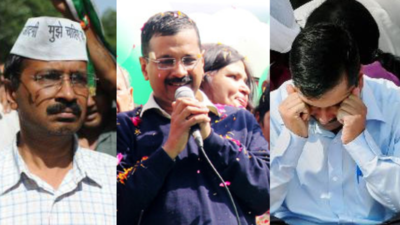NEW DELHI: Revolution. New politics. Political startup. That’s all echoed ten years back as people, particularly in New Delhi, witnessed a “glint of hope” radiating from Ram Lila Maidan.
When the ruling Congress at the Centre faced heat over the unravelling of corruption cases in 2011, the iconic ground in Delhi galvanised the people against what seemed indomitable dispensation.
Delhi Election Results 2025
At the centre of the historic Ram Lila Maidan protest were Anna Hazare and his protege Arvind Kejriwal, leading the masses with a key demand — Jan Lok Pal.
The India Against Corruption movement peaked when the Congress-led UPA regime ordered cops to infiltrate the historic ground to disperse the crowd. The move backfired. It earned the protest nationwide sympathy and made the chances of the government leaner.
Unable to make a big impact from apolitical movement and lack of legislative might, team Kejriwal decided to float a party to bring a “real change” in India’s political landscape.
Consequently, the Aam Aadmi Party (AAP) came into existence on October 2, 2o12, which also marked the birth anniversary of Mahatma Gandhi.
First whiff of power
The political canvas was fresh and blank for Kejriwal to leave an indelible imprint in 2013 when he made his political debut against Sheila Dikshit-led Congress government.
The promise of alternative politics served Kejriwal with a decent electoral dividend as he defeated Sheila Dikshit from the New Delhi seat by a whopping margin of 22,000 votes. However, the party failed to secure a majority as it won 28 seats, only 8 short of the magic mark.
In a first surprise call, the AAP declared to form a government with Congress’s support — the same party protesting against which it had come to prominence. It was, however, seen as an arrangement to navigate through the deadlock the hung mandate had created.
As expected, the government was short-lived as Kejriwal resigned in 49 days because the Lokpal Bill (anti-corruption law) was not passed due to alleged opposition from its ally Congress.
Decimation of opposition
In 2015, the Aam Aadmi Party (AAP) decimated the BJP and Congress by recording a landslide victory as it won 67 of the 70 seats in the Delhi assembly elections, halting the Modi juggernaut in its tracks.
The AAP won more than 90 per cent of the seats, a feat achieved only twice before in Sikkim and Bihar.
Driven by its strong focus on governance and welfare policies, the Kejriwal-led government implemented several popular schemes, such as free electricity (up to 200 units), free water (up to 20,000 litres), improved government schools, and Mohalla Clinics for healthcare. These initiatives resonated with the common people, particularly the lower and middle classes, who saw direct benefits in their daily lives.
The strategy of projecting Kejriwal as a “work-oriented leader” helped AAP secure a massive victory, winning 62 out of 70 seats in the 2020 Delhi Assembly.
From local to national
AAP transitioned from a local party in Delhi to a national party after its massive breakthrough in the 2022 Punjab assembly elections, where Kejriwal’s party won a landslide victory with 92 out of 117 seats, forming its second full-fledged state government. This victory established AAP as a key contender beyond Delhi.
Deep dent of controversies
The two controversies that put AAP and Kejriwal’s credibility under serious scrutiny were the ‘sheesh mahal’ and the Delhi liquor policy case, with critics arguing that the party, which once promised clean politics did not walk the talk.
While the Sheesh Mahal controversy has dented Kejriwal’s image as a leader of simplicity, the liquor policy scam has given the opposition fresh ammunition to attack AAP’s anti-corruption stance. The party, however, remained defiant, insisting that both controversies were politically motivated.
This came after several of the founding members of the party left the AAP, accusing Kejriwal of functioning in a “dictatorial way” and taking unilateral decisions.
ALSO READ: Winners and Losers of Delhi assembly election 2025
The unprecedented fall
Riding high on the anti-incumbency and on the back of the corruption charges, AAP lost its Delhi bastion in the 2025 assembly election. The BJP has managed to breach Kejriwal’s Delhi fortress to regain power after a gap of 27 years. The saffron party won 48 seats in the 70-seat assembly.
When it rains it pours, as the adage goes, the AAP not only lost the election but its chief Arvind Kejriwal was also trounced by BJP’s Parvesh Verma by more than 4,000 votes from the same New Delhi assembly seat, which Kejriwal used for his political debut.
Follow full Delhi election here
